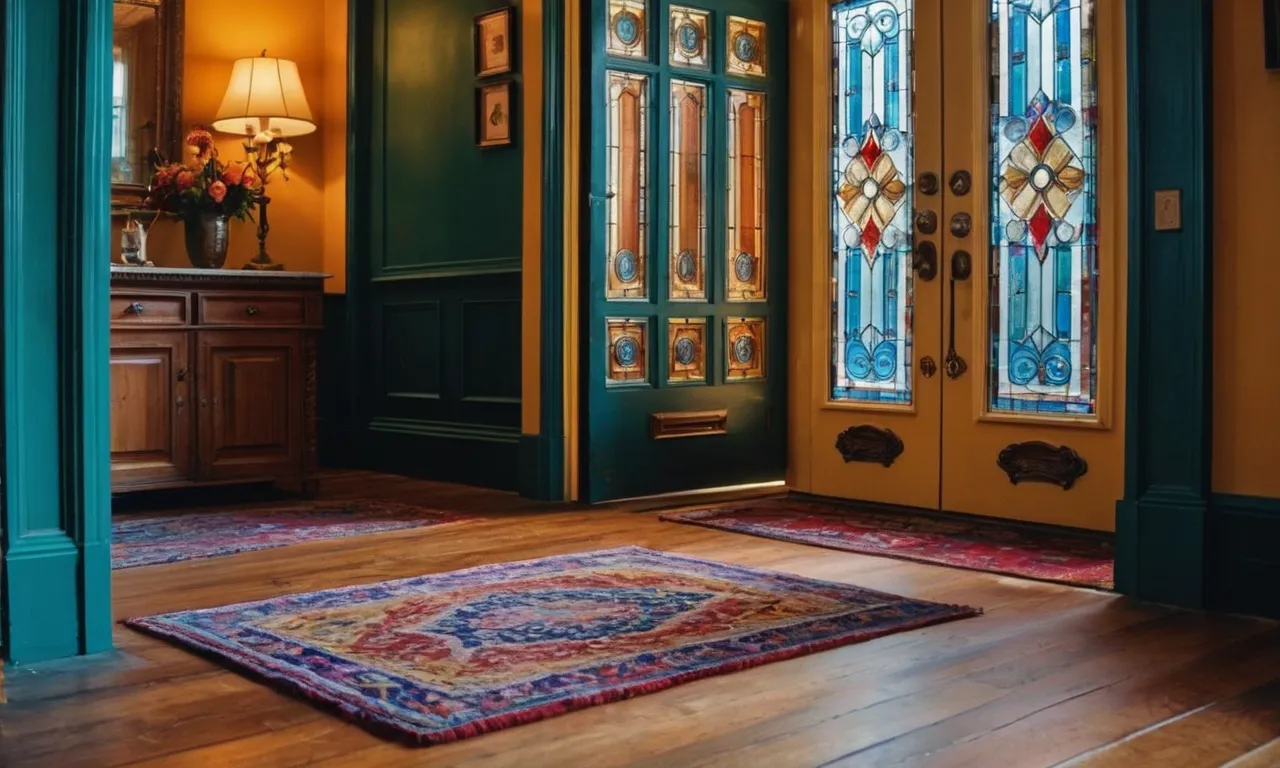A Complete Guide To Painting The Inside Of Your Front Door
Painting the inside of your front door can completely transform the look and feel of your home’s entrance. A fresh coat of paint can make your front door feel brand new again. In this comprehensive guide, we’ll walk you through everything you need to know to paint the inside of your front door.
If you’re short on time, here’s a quick answer: Carefully clean the inside of the door, sand and fill any imperfections, apply primer, and finish with two coats of interior paint in your color of choice, allowing proper drying time between coats.
Preparing the Inside of Your Front Door for Painting
Remove Door Hardware and Weatherstripping
Before you start painting the inside of your front door, it’s important to remove any door hardware and weatherstripping. This includes doorknobs, hinges, and any other accessories that are attached to the door.
Removing these items will allow you to paint the door evenly and avoid getting paint on them. Additionally, taking off the weatherstripping will ensure that you can paint the entire surface of the door without any obstructions.
Clean the Surface Thoroughly
Once you have removed the door hardware and weatherstripping, it’s time to clean the surface of the door thoroughly. Use a mild detergent mixed with water to remove any dirt, grease, or grime that may have accumulated on the door.
Scrub the surface gently with a sponge or soft cloth, paying attention to any particularly dirty areas. After cleaning, rinse the door with clean water and allow it to dry completely before proceeding to the next step.
This will help ensure that the paint adheres properly and provides a smooth finish.
Fill Any Holes, Cracks or Imperfections
After cleaning the door, carefully inspect the surface for any holes, cracks, or imperfections. These can be filled using wood filler or spackle, depending on the material of your door. Apply the filler or spackle to the affected areas, smoothing it out with a putty knife.
Allow it to dry completely and then sand the filled areas until they are smooth and level with the rest of the door. This step is crucial to ensure a professional-looking finish once the door is painted.
Sand the Surface
Before you can start painting, it’s important to sand the surface of the door. This will help remove any rough patches or uneven areas, allowing the paint to adhere properly. Use a fine-grit sandpaper and sand the entire surface of the door in a circular motion.
Be sure to sand the edges and corners as well. After sanding, wipe away any dust with a clean cloth or tack cloth.
By following these steps to prepare the inside of your front door for painting, you’ll be well on your way to achieving a professional-looking finish. Remember to take your time and pay attention to detail, as proper preparation is key to a successful paint job.
Choosing the Right Paint and Supplies
When it comes to painting the inside of your front door, choosing the right paint and supplies is crucial for achieving a professional-looking finish. Here are some tips to help you make the right choices:
Pick Interior Paint in Your Desired Finish and Sheen
First and foremost, decide on the finish and sheen you want for your front door. Satin or semi-gloss finishes are popular choices as they provide a durable and easy-to-clean surface. Matte finishes, on the other hand, offer a more subtle and elegant look.
Consider the style and design of your home when selecting the finish.
Additionally, it’s important to choose interior paint that is specifically designed for doors and trim. These paints are formulated to withstand frequent use and resist chipping and peeling.
Select Paint Supplies Like Brushes, Rollers, Tray, Drop Cloth
Once you have chosen the paint, gather the necessary supplies. You will need brushes, rollers, a paint tray, and a drop cloth to protect the surrounding area. Make sure to invest in high-quality brushes and rollers to ensure smooth and even application of the paint. Synthetic brushes are ideal for water-based paints, while natural bristle brushes work well with oil-based paints.
A paint tray with a liner will make the process more convenient, allowing you to easily switch between colors. Don’t forget to cover the floor and any nearby furniture with a drop cloth or plastic sheet to prevent accidental spills and splatters.
Don’t Forget Primers and Fillers
Before painting your front door, it’s important to prepare the surface properly. This includes applying a primer to ensure better adhesion and a smoother finish. Primers also help to seal the surface and prevent the paint from peeling or chipping in the future.
Choose a primer that is suitable for the type of paint you will be using.
If your front door has any cracks, dents, or imperfections, use a filler to repair them before painting. This will help create a smooth and even surface for the paint to adhere to. Sand down any rough areas and wipe away the dust before applying the primer.
Remember, proper preparation and the right choice of paint and supplies are key to achieving a beautiful and long-lasting finish when painting the inside of your front door.
Applying Primer and Paint to the Inside of the Door
Start by Applying Primer
Before you begin painting the inside of your front door, it’s crucial to apply a primer. Primer helps the paint adhere better to the surface, ensuring a long-lasting and smooth finish. Choose a primer specifically designed for the material of your door, whether it’s wood, metal, or fiberglass.
You can find a variety of primers at your local home improvement store or online.
Allow Primer to Dry Completely Before Painting
Once you have applied the primer, it’s important to allow it to dry completely before moving on to the painting step. The drying time will vary depending on the type of primer you use and the climate in your area. It’s best to follow the manufacturer’s instructions for drying time.
Patience is key here, as painting over wet or tacky primer can ruin the final result.
Apply Two Coats of Paint for Best Coverage
After the primer has dried, it’s time to apply the paint. For the best coverage and durability, it’s recommended to apply two coats of paint. This will ensure that the color looks vibrant and even. Choose a high-quality paint that is specifically formulated for interior doors.
Consider the color scheme of your home and select a paint color that complements the overall aesthetic.
Let Paint Dry Fully Between Coats
Once you have applied the first coat of paint, it’s important to allow it to dry fully before applying the second coat. This will prevent smudging or streaking of the paint. Again, the drying time will vary depending on the type of paint and the climate.
It’s best to wait at least a few hours or overnight before applying the second coat. This will ensure a flawless finish.
Caring for the Newly Painted Surface
Once you have successfully painted the inside of your front door, it is important to take proper care of the newly painted surface to ensure its longevity and durability. Here are some essential tips to keep in mind:
Allow at Least 24 Hours Before Reattaching Hardware
After painting your front door, it is crucial to give the paint enough time to dry and cure properly. This usually takes around 24 hours, but it may vary depending on the type of paint and the specific conditions in your home.
It’s best to consult the paint manufacturer’s instructions for the recommended drying time.
Once the paint has fully dried, you can reattach the hardware such as doorknobs, locks, and hinges. However, be cautious not to overtighten the screws, as this could cause damage to the freshly painted surface.
Be Gentle When First Closing the Door
When closing the freshly painted front door for the first time, it’s important to be gentle to avoid any accidental damage. The paint may still be slightly tacky, and applying too much force or slamming the door shut could result in scratches or smudges.
Take your time and close the door gently, ensuring that it aligns properly with the frame. If you notice any resistance or sticking, it may be necessary to sand or adjust the door to ensure smooth operation.
Keep Door Closed to Avoid Damage While Curing
While the paint is curing, it is advisable to keep the front door closed as much as possible to avoid any potential damage. This will help prevent accidental bumps, scratches, or smudges that could occur if the door is frequently opened and closed.
Consider temporarily using an alternative entrance if possible, especially if you anticipate heavy traffic in and out of your home during the curing period. This precautionary measure will ensure that the paint cures undisturbed and results in a flawless finish.
Consider Adding a Protective Clear Coat
If you want to provide an extra layer of protection for your newly painted front door, you may consider applying a clear coat. A clear coat acts as a barrier, shielding the paint from daily wear and tear, UV rays, and moisture.
Before applying a clear coat, make sure to clean the painted surface thoroughly and remove any dust or debris. Follow the manufacturer’s instructions for the application process and allow sufficient drying time.
Adding a clear coat can help extend the lifespan of your front door’s paint job and keep it looking fresh and vibrant for years to come.
Remember, proper care and maintenance are essential for preserving the beauty and longevity of your newly painted front door. By following these tips, you can ensure that your hard work pays off and enjoy a stunning entrance to your home.
Conclusion
By following this comprehensive guide, you can paint the inside of your front door with beautiful, professional-looking results. Proper preparation, high-quality primer and paint, and attention to drying times will ensure your freshly painted door looks its best and lasts.
Transforming your front entrance with a new interior door color is a fast, easy way to update your home’s curb appeal.







